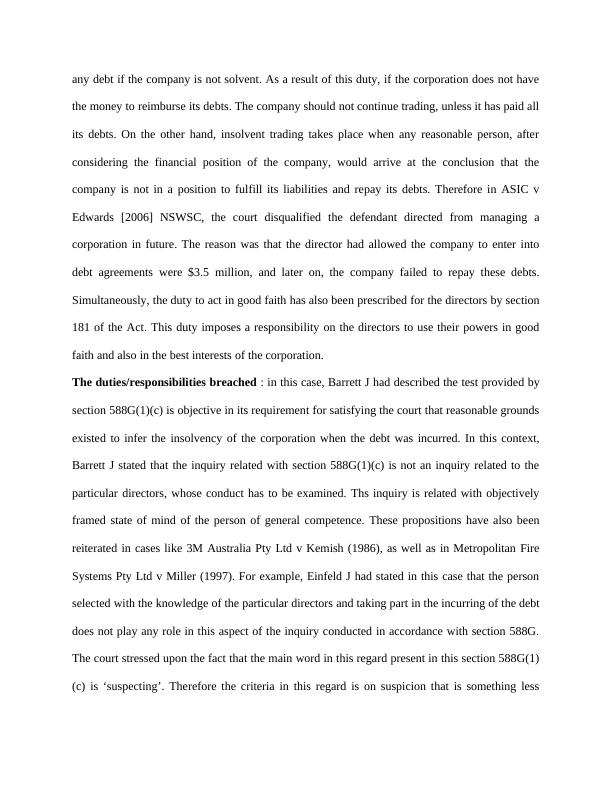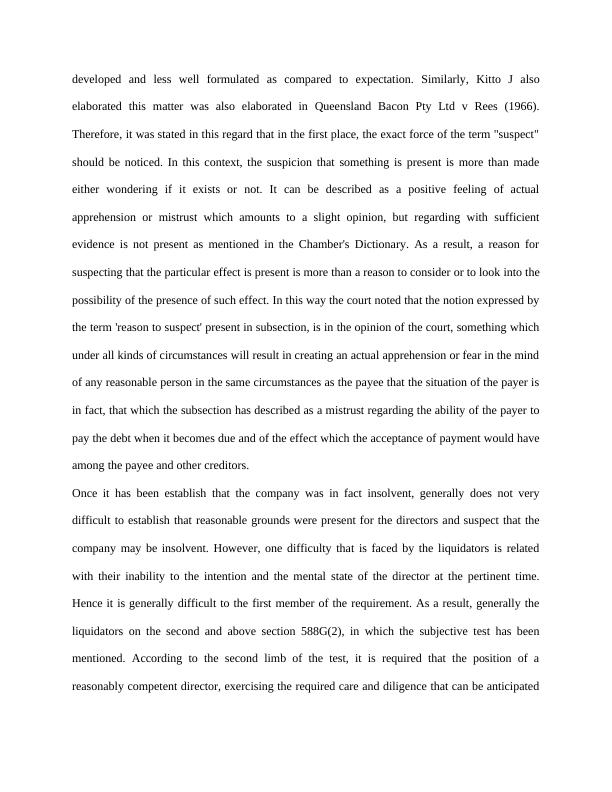Groeneveld Australia Pty Ltd Assignment PDF
Added on 2021-06-17
7 Pages2225 Words45 Views
Groeneveld Australia Pty Ltd & Ors v Nolten & Ors (No 3) [2010] Case introduction: In Groeneveld Australia Pty Ltd & Ors v Nolten (2010), illustrated by the Supreme Court ofVictoria that a director of the company was added to be in the breach of his statutory as well asfiduciary duties on account of the fact that while he was acting as a managing director of thecompany, he failed to disclose the presence of conflict of interest. But the effects of this case arethat Mr. Nolton was the defendant in this case was acting as the managing director ofGroeneveld Australia Pty Ltd. In this case, a number of situations were considered by the courtwhere Mr. Norton had straightaway or through the corporations that were controlled by him,attained significant benefits and he failed to disclose the fact regarding these benefits to thecompany where he was acting as a managing director. In this regard, one major claim was relatedwith the put and call options that were held by Mr. Nolten The directors of publicly listed companies and also proprietary companies have to deal with thecomplexities concerning the business decision-making. At the same time, it is also necessary thatthe directors fulfill the duties that have been imposed on them by the state to the law and also bythe common law. On the other hand, if it is found that the director who has breached these dutiesmay be held personally responsible and as a result, may have to face civil or criminal penaltiesincluding imprisonment, fine or disqualification. A significant degree in this regard has beenimposed on the directors by s588G of the Corporations Act. According to the duty imposed bythis section it is necessary that the directors should not allow the company to create and incur

any debt if the company is not solvent. As a result of this duty, if the corporation does not havethe money to reimburse its debts. The company should not continue trading, unless it has paid allits debts. On the other hand, insolvent trading takes place when any reasonable person, afterconsidering the financial position of the company, would arrive at the conclusion that thecompany is not in a position to fulfill its liabilities and repay its debts. Therefore in ASIC vEdwards [2006] NSWSC, the court disqualified the defendant directed from managing acorporation in future. The reason was that the director had allowed the company to enter intodebt agreements were $3.5 million, and later on, the company failed to repay these debts.Simultaneously, the duty to act in good faith has also been prescribed for the directors by section181 of the Act. This duty imposes a responsibility on the directors to use their powers in goodfaith and also in the best interests of the corporation. The duties/responsibilities breached: in this case, Barrett J had described the test provided bysection 588G(1)(c) is objective in its requirement for satisfying the court that reasonable groundsexisted to infer the insolvency of the corporation when the debt was incurred. In this context,Barrett J stated that the inquiry related with section 588G(1)(c) is not an inquiry related to theparticular directors, whose conduct has to be examined. Ths inquiry is related with objectivelyframed state of mind of the person of general competence. These propositions have also beenreiterated in cases like 3M Australia Pty Ltd v Kemish (1986), as well as in Metropolitan FireSystems Pty Ltd v Miller (1997). For example, Einfeld J had stated in this case that the personselected with the knowledge of the particular directors and taking part in the incurring of the debtdoes not play any role in this aspect of the inquiry conducted in accordance with section 588G.The court stressed upon the fact that the main word in this regard present in this section 588G(1)(c) is ‘suspecting’. Therefore the criteria in this regard is on suspicion that is something less

developed and less well formulated as compared to expectation. Similarly, Kitto J alsoelaborated this matter was also elaborated in Queensland Bacon Pty Ltd v Rees (1966).Therefore, it was stated in this regard that in the first place, the exact force of the term "suspect"should be noticed. In this context, the suspicion that something is present is more than madeeither wondering if it exists or not. It can be described as a positive feeling of actualapprehension or mistrust which amounts to a slight opinion, but regarding with sufficientevidence is not present as mentioned in the Chamber's Dictionary. As a result, a reason forsuspecting that the particular effect is present is more than a reason to consider or to look into thepossibility of the presence of such effect. In this way the court noted that the notion expressed bythe term 'reason to suspect' present in subsection, is in the opinion of the court, something whichunder all kinds of circumstances will result in creating an actual apprehension or fear in the mindof any reasonable person in the same circumstances as the payee that the situation of the payer isin fact, that which the subsection has described as a mistrust regarding the ability of the payer topay the debt when it becomes due and of the effect which the acceptance of payment would haveamong the payee and other creditors.Once it has been establish that the company was in fact insolvent, generally does not verydifficult to establish that reasonable grounds were present for the directors and suspect that thecompany may be insolvent. However, one difficulty that is faced by the liquidators is relatedwith their inability to the intention and the mental state of the director at the pertinent time.Hence it is generally difficult to the first member of the requirement. As a result, generally theliquidators on the second and above section 588G(2), in which the subjective test has beenmentioned. According to the second limb of the test, it is required that the position of areasonably competent director, exercising the required care and diligence that can be anticipated

End of preview
Want to access all the pages? Upload your documents or become a member.
Related Documents
Groeneveld Australia Pty Ltd & Ors v Nolten & Ors (No 3) [2010] VSC 533lg...
|12
|1234
|24
Groeneveld Australia Pty Ltd & Ors v Nolten & Ors (No 3) [2010] VSC 533lg...
|8
|2602
|1
Corporate Law Assignment Case Studylg...
|10
|2601
|119
Business and Corporations Law - Assignmentlg...
|10
|887
|280
ASIC v Padbury Mining Limited: Breach of Directors' Dutieslg...
|12
|1068
|427
Company Law - Asden Developments Pty Ltd v Dinorislg...
|8
|2408
|319
